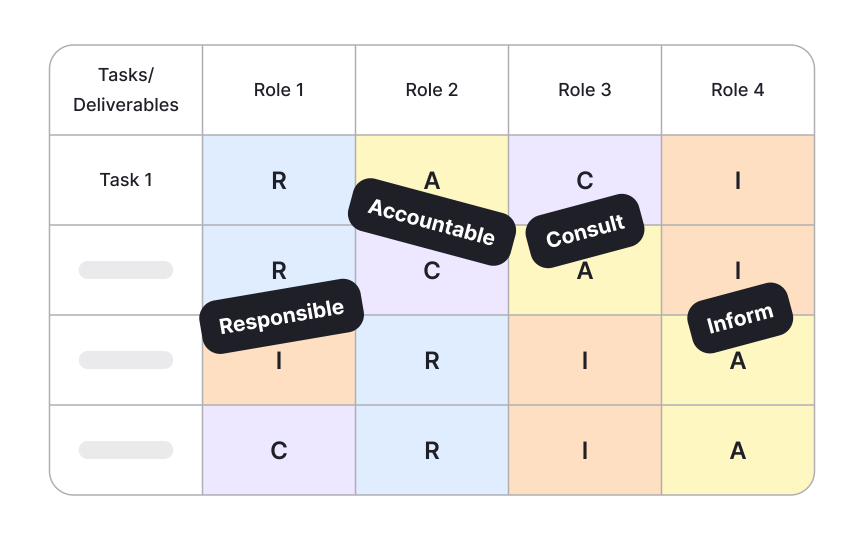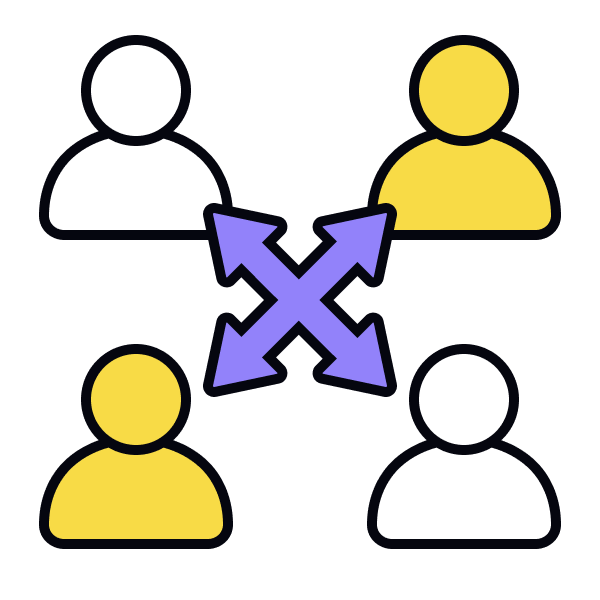Roles and Responsibilities in Design and Product Teams
Discover the key roles, responsibilities, and collaboration patterns in modern product teams
Cross-functional teams emerge when a project needs varied expertise, fostering collaboration and faster problem-solving. They help bridge the gap between different functions, ensuring that decisions consider multiple perspectives, enhancing the final product.
In such teams, roles and responsibilities vary based on the project, team size, and goals. Typically, these teams include product managers, designers, engineers, and sometimes researchers, marketers, sales specialists, or analysts, each bringing forth unique skills. Product managers lead strategy and prioritize features, designers focus on user experience and interface, and engineers bring the concepts to life through development.
However, responsibilities often shift depending on project complexity or scope. For instance, in agile projects, teams are more flexible, with members sometimes taking on overlapping roles.
Product managers drive product vision, strategy, and development while balancing business goals with user needs. Their multifaceted role includes:
- Strategic planning: Defining product vision, setting objectives, and creating actionable roadmaps that align with company goals.
- Stakeholder management: Coordinating between executives, development teams, and customers while maintaining clear communication channels.
- Requirements management: Gathering, analyzing, and prioritizing product requirements based on user research, market analysis, and business constraints.
- Data-driven decision making: Using analytics, user feedback, and market trends to guide product direction and measure success metrics.
- Team leadership: Guiding cross-functional teams through the product lifecycle while removing obstacles and maintaining momentum.
- Resource optimization: Balancing available resources, timeline constraints, and quality requirements to maximize product value delivery.
While product managers oversee the product's overall strategy, roadmap, and business goals, UX designers focus on creating user-friendly experiences through design and research. Their specialized role includes:
- User research: Conducting interviews, surveys, and usability tests to understand user needs and behaviors.
- Information architecture: Structuring content and user flows to create logical, intuitive navigation systems.
- Interaction design: Planning how users move through the product and interact with features.
- Wireframing: Creating low-fidelity representations of screens and user interfaces.
- Usability testing: Evaluating design solutions through user testing and iterative improvements.
- User advocacy: Representing user needs in product decisions and maintaining user-centered focus.
A UX designer's scope of work often varies depending on the organization's size. In larger companies, they may collaborate with specialists in specific areas of
UI designers are responsible for making digital products visually engaging and easy to navigate. They focus on the look and feel of each screen, ensuring users enjoy a seamless, attractive experience. Key responsibilities include:
- Visual design: Creating the product’s color schemes, typography, icons, and layout.
- Brand alignment: Ensuring the design reflects the brand’s identity and tone.
- Consistency: Applying styles consistently across all screens for a cohesive feel.
- Interactive elements: Designing buttons, sliders, and other components that are clear and engaging.
- Collaboration with UX designers: Working together to make sure the visual design supports an intuitive
user experience .
UI designers balance aesthetics and functionality, making sure the interface looks great and feels natural to use.
- Content strategy: Developing content frameworks and guidelines that align with product and user goals.
- Microcopy creation: Writing clear interface text, including
buttons , error messages, and form fields to guide users in their goals. - Voice and tone: Maintaining consistent
brand voice across all product touchpoints anduser flows . - Content hierarchy: Structuring information to support user understanding and task completion.
- User assistance: Creating helper text, tooltips, and documentation that enhance user experience.
- Localization support: Ensuring content can be effectively translated and adapted for different markets.
Developers transform design concepts into functional digital products through code implementation and technical problem-solving. Their role includes:
- Technical implementation: Writing clean, efficient code that brings designs to life while maintaining performance.
- Problem-solving: Finding innovative solutions to technical challenges while considering scalability.
- Code architecture: Planning and implementing sustainable code structures for long-term maintenance.
- Quality assurance: Testing code thoroughly to ensure functionality and catch potential issues early.
- Technical collaboration: Working with designers and product managers to balance feasibility with vision.
- Performance optimization: Ensuring fast load times and smooth functionality across different devices.
Marketing and sales specialists bridge user acquisition and product development. Their collaborative involvement includes:
- Go-to-market strategy: Aligning product features with market positioning and sales narratives.
- User feedback channels: Gathering market insights and user feedback to inform product decisions.
- Value proposition: Helping define and validate product messaging and key benefits to align with customer needs.
- Sales enablement: Creating materials and processes that support effective product selling.
- Launch planning: Coordinating product releases with marketing campaigns and sales readiness.
- Market analysis: Providing competitive insights and market trends to inform product direction.
Supporting specialists in larger organizations provide additional expertise that enhances product development and ensures comprehensive quality. Their diverse roles include but are not limited to:
- Quality analytics (QA) engineering: Testing product functionality, identifying bugs, and ensuring quality standards are met.
- Data analysis: Gathering insights from user behavior, market trends, and product performance metrics.
- User research: Conducting in-depth
research studies to understand user needs and validate solutions. - DevOps: Managing deployment processes, maintaining infrastructure, and ensuring system reliability.
- Business analysis: Analyzing market conditions and business requirements to inform product decisions.
- Service design: Orchestrating how products, people, infrastructure, and communication work together to form a seamless service experience.
While organizational structures vary, most companies incorporate some version of these roles to support their product development processes.
Accountability frameworks help cross-functional teams stay on track by defining roles, expectations, and ownership. Each team member knows their responsibilities, which reduces overlap and confusion.
To set up an accountability framework in cross-functional teams:
- Define roles and responsibilities: Clearly outline each team member’s role to prevent overlap and ensure accountability.
- Set success metrics: Establish measurable goals and KPIs for both individual and team performance to track progress effectively.
- Clarify decision authority: Identify who has the final say in different situations, so decision-making is smooth and confusion-free.
- Implement progress tracking: Use tools or systems to monitor task completion and milestones, ensuring visibility across the team.
- Create feedback loops: Schedule regular check-ins and review sessions to address progress and make adjustments as needed.
- Establish escalation paths: Define a process for resolving roadblocks and conflicts, ensuring issues are addressed promptly.
One way to establish accountability in teams is by using the RACI matrix or responsibility assignment matrix, a simple tool that helps teams clarify roles and responsibilities for each task or decision. RACI stands for:
- Responsible: The person who does the work to complete the task
- Accountable: The person who makes final decisions and takes ownership of the outcome
- Consulted: Stakeholders whose feedback is essential before completing the task
- Informed: People who need to be kept in the loop about progress and outcomes[1]
By assigning these roles, you can prevent overlap, confusion, and missed steps within teams. It also makes it easy to see who to contact for updates or decisions. It is especially useful for larger teams or projects, ensuring everyone knows their part in achieving success.
In cross-functional teams, workload balance is crucial for maintaining productivity and team morale. When tasks are fairly distributed, team members can focus on their strengths, reducing burnout and ensuring everyone contributes effectively and consistently over time.
Key principles of workload balance include:
- Prioritization: Tackling high-impact tasks first to make sure the team is focused on what matters most.
- Capacity assessment: Considering each person’s skills and current workload to assign tasks that fit their expertise and availability.
- Flexibility: Allowing adjustments as priorities shift, so no one is overwhelmed by unexpected tasks.
- Clear communication: Keeping everyone informed about deadlines, expectations, and changes so the team can adapt smoothly.
- Regular check-ins: Reviewing workloads frequently to catch and address imbalances early on.[2]
By following these principles, cross-functional teams can stay productive, reduce stress, and work together more effectively.
References
Top contributors
Topics
From Course
Share
Similar lessons

Continuous Discovery Mindset

Business Outcomes vs. Product Outcomes



















